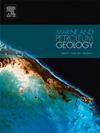Effects of outcrop-scale structural and diagenetic heterogeneities on flow and mass transport in a porous sandstone aquifer
IF 3.7
2区 地球科学
Q1 GEOSCIENCES, MULTIDISCIPLINARY
引用次数: 0
Abstract
We apply outcrop-based structural and in-situ petrophysical properties measurements for the construction of flow and mass transport calibrated numerical models in a porous sandstone aquifer. The hydraulic conductivity in this aquifer is influenced by the presence of deformation bands and related carbonate nodules. These heterogeneities are shown to decrease the hydraulic conductivity of the host rock by 2–3 orders of magnitude. The result obtained is robust, given that the models were calibrated with hydrologic field data. Our upscaling methodology for hydraulic conductivity allows inclusion of outcrop-scale structures and diagenetic features by means of inversion of the advective velocity for conservative particles. This approach can be used for easily implementing field data in aquifers or other geofluids reservoir simulators. Our experiments show that the use of an equivalent isotropic hydraulic conductivity approach fails to correctly account for mass transport in porous sandstone aquifers and we recommend implementing, as much as possible, the local heterogeneities and anisotropies in hydraulic conductivity within the model to be able to have a more realistic and conservative estimate of advection and dispersion. Our findings should be helpful to those scientists dealing with geofluids modeling and groundwater pollution.
求助全文
约1分钟内获得全文
求助全文
来源期刊

Marine and Petroleum Geology
地学-地球科学综合
CiteScore
8.80
自引率
14.30%
发文量
475
审稿时长
63 days
期刊介绍:
Marine and Petroleum Geology is the pre-eminent international forum for the exchange of multidisciplinary concepts, interpretations and techniques for all concerned with marine and petroleum geology in industry, government and academia. Rapid bimonthly publication allows early communications of papers or short communications to the geoscience community.
Marine and Petroleum Geology is essential reading for geologists, geophysicists and explorationists in industry, government and academia working in the following areas: marine geology; basin analysis and evaluation; organic geochemistry; reserve/resource estimation; seismic stratigraphy; thermal models of basic evolution; sedimentary geology; continental margins; geophysical interpretation; structural geology/tectonics; formation evaluation techniques; well logging.
 求助内容:
求助内容: 应助结果提醒方式:
应助结果提醒方式:


